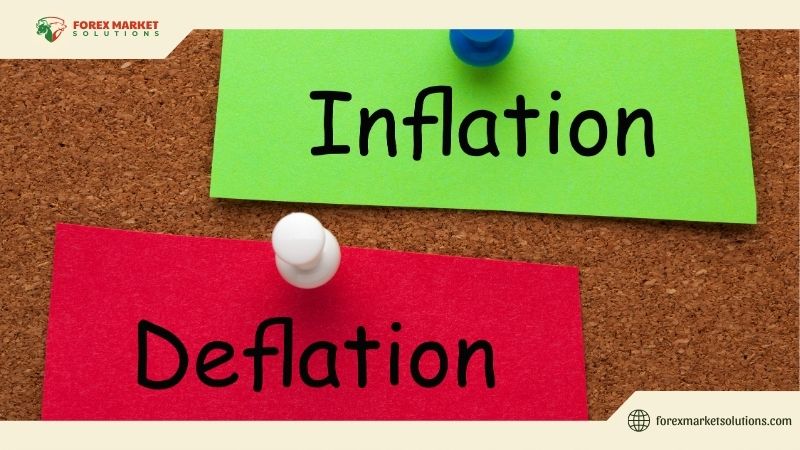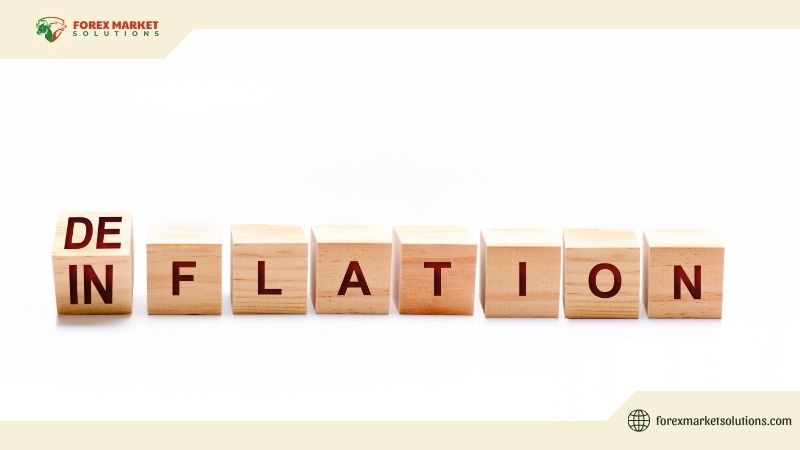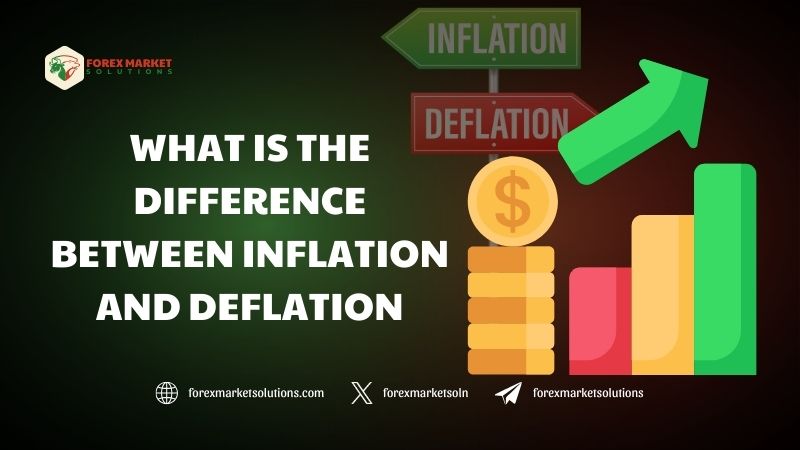In the realm of economics and financial markets, terms like inflation and deflation are frequently discussed, yet their implications are not always clear. Understanding what is the difference between inflation and deflation is essential for traders, investors, and anyone navigating the global economy. Inflation refers to a sustained increase in the general price level of goods and services, while deflation is the opposite—a persistent decline in prices. Both phenomena have profound effects on purchasing power, monetary policy, and market dynamics. This article explores the key distinctions, their causes, impacts, and how traders can respond to these economic forces.

Defining Inflation and Deflation
To grasp what is the difference between inflation and deflation, it’s crucial to start with their definitions. Inflation occurs when the prices of goods and services rise over time, reducing the purchasing power of money. For example, if a loaf of bread costs $2 today but $2.20 next year, that’s inflation at work. It’s typically measured by indices like the Consumer Price Index (CPI) or Producer Price Index (PPI).
Deflation, conversely, is a sustained decrease in the general price level, increasing the value of money. In a deflationary environment, that same loaf of bread might drop to $1.80. While falling prices may seem beneficial, deflation can signal economic stagnation. Understanding what is the difference between inflation and deflation begins with recognizing these opposing effects on prices and money’s value.
Causes of Inflation and Deflation
The causes behind inflation and deflation further highlight what is the difference between inflation and deflation. Inflation is often driven by demand-pull factors, where consumer demand outpaces supply, pushing prices higher. It can also result from cost-push factors, such as rising production costs due to higher wages or commodity prices. Central banks, like the Federal Reserve, may contribute to inflation by increasing the money supply through low interest rates or quantitative easing.
Deflation, on the other hand, typically arises from reduced consumer demand, often during economic downturns. Businesses lower prices to attract customers, creating a deflationary spiral. Technological advancements can also cause deflation by reducing production costs, leading to cheaper goods. Additionally, tight monetary policies, where central banks raise interest rates or reduce money supply, can trigger deflation. These contrasting causes underscore what is the difference between inflation and deflation in economic contexts.

Economic Impacts of Inflation
Inflation’s effects on the economy are a key aspect of what is the difference between inflation and deflation. Moderate inflation, often targeted at 2% by central banks, is seen as a sign of a healthy economy, encouraging spending and investment. However, high inflation erodes purchasing power, as consumers need more money to buy the same goods. This can lead to reduced savings and higher borrowing, potentially destabilizing economies.
For businesses, inflation increases input costs, squeezing profit margins unless prices are passed on to consumers. It also influences monetary policy, prompting central banks to raise interest rates to curb price rises, which can slow economic growth. In Forex markets, inflation strengthens a country’s currency if it signals robust economic activity but weakens it if it spirals out of control. Recognizing these impacts is critical to understanding what is the difference between inflation and deflation.
Economic Impacts of Deflation
Deflation’s consequences contrast sharply with inflation, further clarifying what is the difference between inflation and deflation. While falling prices may benefit consumers initially, deflation often signals economic trouble. As prices drop, consumers may delay purchases, expecting even lower prices, which reduces demand and slows economic activity. Businesses, facing lower revenues, may cut wages, lay off workers, or reduce investments, deepening economic contraction.
Deflation also increases the real value of debt, making it harder for borrowers to repay loans, which can lead to defaults and financial instability. Central banks struggle to combat deflation, as interest rates near zero limit their ability to stimulate the economy. In Forex markets, deflation typically weakens a currency, reflecting economic weakness. These dynamics highlight what is the difference between inflation and deflation in terms of economic outcomes.

Inflation vs. Deflation in Forex Trading
For Forex traders, understanding what is the difference between inflation and deflation is vital for anticipating currency movements. Inflation affects currency value through its impact on interest rates and economic health. A country with moderate inflation may see its currency appreciate, as central banks raise rates to control price growth, attracting foreign investment. However, hyperinflation can devalue a currency, as seen in historical cases like Zimbabwe.
Deflation, conversely, often weakens a currency, as it signals economic stagnation and prompts central banks to cut rates or implement stimulus. For example, during deflationary periods in Japan, the yen faced downward pressure. Traders can monitor inflation indicators, like CPI, and deflation signals, such as declining producer prices, to predict market trends. Leveraging these insights is a practical application of understanding what is the difference between inflation and deflation.
Strategies for Trading in Inflationary Environments
Trading during inflation requires specific strategies, tied to what is the difference between inflation and deflation. In an inflationary environment, traders might focus on currencies from countries with strong economic growth and rising interest rates, such as the U.S. dollar during periods of Fed tightening. Pairs like USD/JPY or USD/CHF may offer opportunities, as the dollar strengthens against lower-yielding currencies.
Commodities like gold or oil often perform well during inflation, as investors seek hedges against rising prices. Forex traders can also use technical analysis to identify trends in currency pairs driven by inflation data, such as CPI releases. Risk management, including stop-loss orders, is crucial to protect against volatility from unexpected inflation spikes. These strategies align with the economic dynamics of what is the difference between inflation and deflation.
Strategies for Trading in Deflationary Environments
Deflationary periods demand a different approach, further illustrating what is the difference between inflation and deflation. Traders may favor safe-haven currencies, like the Japanese yen or Swiss franc, which tend to strengthen during economic uncertainty. Pairs such as USD/JPY or EUR/CHF can be monitored for bearish trends in weaker currencies.
Bonds and fixed-income assets may also gain value in deflation, as falling prices increase the real return on interest payments. Forex traders should watch for central bank actions, such as quantitative easing, which can influence currency values. Using fundamental analysis to track deflationary indicators, like unemployment or consumer spending, helps traders anticipate market shifts. These tactics reflect the unique challenges of what is the difference between inflation and deflation in trading.

Long-Term Implications for Economies
The long-term effects of inflation and deflation further clarify what is the difference between inflation and deflation. Persistent inflation can erode savings and fixed incomes, disproportionately affecting retirees and low-income households. It may also lead to wage-price spirals, where rising wages fuel further price increases, destabilizing economies. Over time, unchecked inflation can undermine confidence in a currency, as seen in historical hyperinflation cases.
Prolonged deflation, however, can trap economies in a cycle of low growth and high unemployment, as seen in Japan’s “Lost Decades.” It discourages investment and innovation, as businesses face shrinking profits. Central banks may resort to unconventional policies, like negative interest rates, to combat deflation, but these measures have limited effectiveness. These contrasting long-term impacts emphasize what is the difference between inflation and deflation for economic stability.
Preparing for Inflation and Deflation as a Trader
To navigate these economic conditions, traders must stay informed about what is the difference between inflation and deflation. Monitor key indicators, such as CPI, PPI, and unemployment data, to anticipate inflationary or deflationary trends. Follow central bank announcements, as policy changes directly affect currency values and market sentiment.
Diversifying your portfolio across currencies, commodities, and bonds can mitigate risks from inflation or deflation. For example, holding gold during inflation or bonds during deflation can balance exposure. Practicing disciplined risk management, such as setting stop-loss orders and limiting leverage, protects against volatility driven by these economic forces. Preparation is key to leveraging what is the difference between inflation and deflation for trading success.
Mastering Inflation and Deflation for Trading Success
Understanding what is the difference between inflation and deflation is a fundamental skill for anyone involved in financial markets. Inflation drives rising prices and influences interest rate hikes, while deflation signals falling prices and economic slowdown. Each has distinct causes, impacts, and trading strategies, shaping currency values and market trends. By mastering these concepts, traders can anticipate market movements, manage risks, and seize opportunities.
Ready to deepen your knowledge of economic trends and trading strategies? Visit Forex Market Solutions for expert insights, market analysis, and resources to enhance your trading journey. Follow our website today to stay ahead in understanding what is the difference between inflation and deflation and more!
